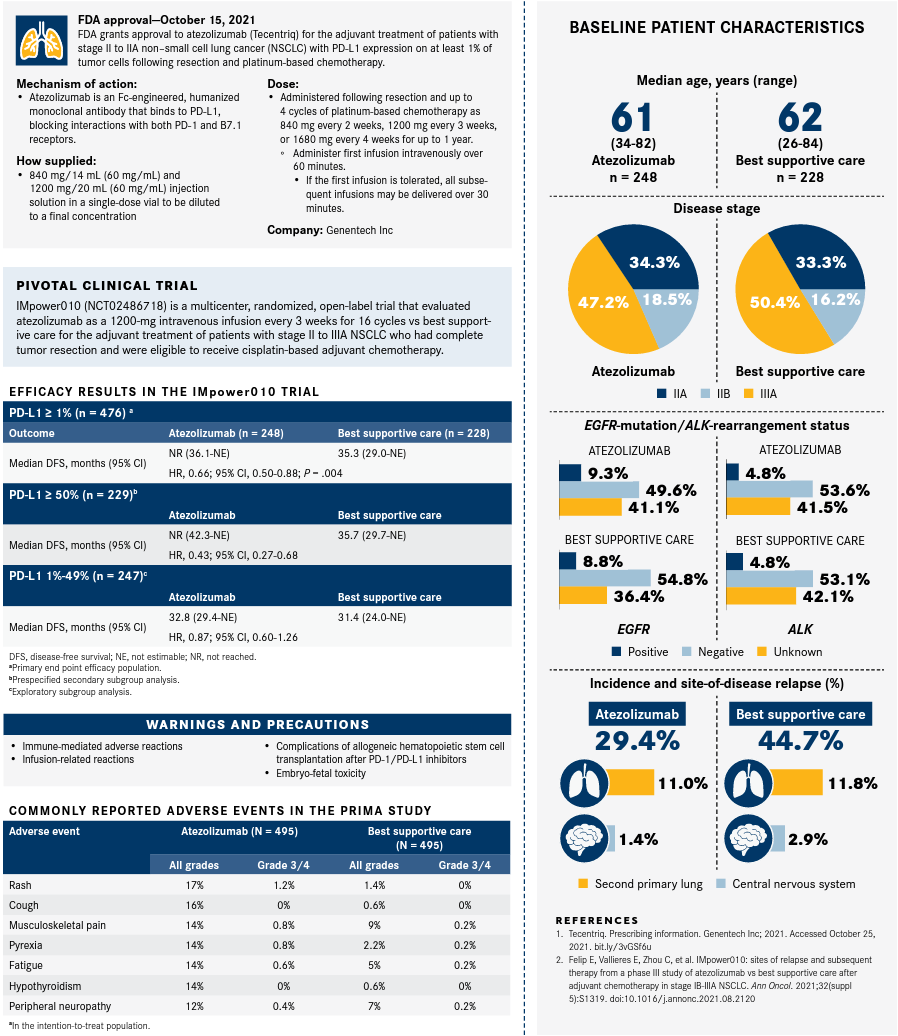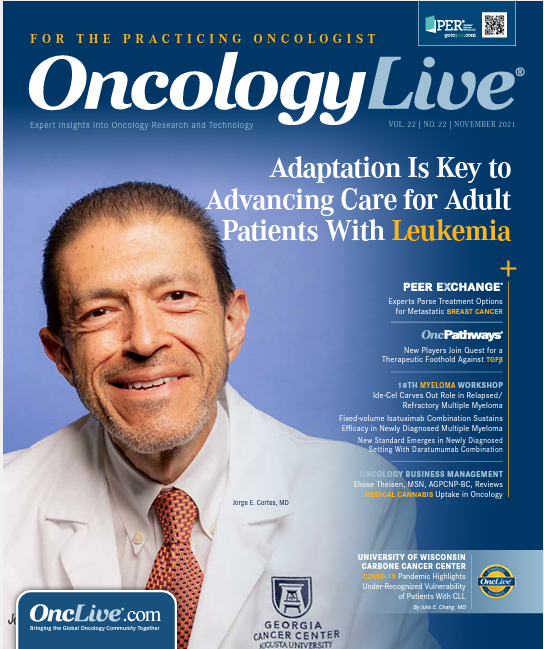Publication
Article
Oncology Live®
Atezolizumab Provides Option for Patients With NSCLC at High Risk of Recurrence
Author(s):
Nasser Khaled Altorki, MD, provides insight on the results of the IMpower010 trial as well as post hoc analyses from the trial and what they signal for the remainder of this patient population.
Nasser Khaled Altorki, MD

Adjuvant atezolizumab (Tecentriq) outperformed best supportive care according to results from the phase 3 IMpower010 trial (NCT02486718), which supported FDA approval of the agent for patients with stage II to IIIA non–small cell lung cancer (NSCLC) with PD-L1 expression on at least 1% of tumor cells following resection and platinum-based chemotherapy.1
Investigator-assessed disease-free survival (DFS) served as the major efficacy outcome for the decision. The median DFS was not reached (95% CI, 36.1-not estimable [NE]) in the atezolizumab arm (n = 248) compared with 35.3 months (95% CI, 29.0-NE) in the best supportive care arm (n = 228; HR, 0.66; 95% CI, 0.50-0.88; P = .004).2 Exploratory analysis of overall survival in this population demonstrated an HR of 0.77 (95% CI, 0.51-1.17). A prespecified secondary subgroup analysis demonstrated a 57% reduction in the risk of progression or death in patients who received atezolizumab vs best supportive care in patients with PD-L1 expression on at least 50% of tumor cells (HR, 0.43; 95% CI, 0.27-0.68). The median DFS was not reached (95% CI, 42.3-NE) vs 35.7 months (95% CI, 29.7-NE), respectively.
In an interview OncLive®, Nasser Khaled Altorki, MD, provided insight on the results of the IMpower010 trial as well as post hoc analyses from the trial and what they signal for the remainder of this patient population. Altorki is a professor of cardiothoracic surgery and director of the Division of Thoracic Surgery at NewYork-Presbyterian Weill Cornell Medical Center in New York, New York.
OncLive: Please discuss the rationale for the IMpower010 trial.
Altorki: Disease relapse and survival are an issue for patients with unresectable NSCLC and for patients with [stage] IB to III disease. You can estimate recurrence rates to be anywhere [from] 40% to 70%. [Thus far, results from] randomized trials with adjuvant chemotherapy showed a 5% improvement in survival with [aromatase inhibitor]–driven chemotherapy. There haven’t been any big advances in that space [except for] of the ADAURA trial [NCT02511106], which randomized patients with EGFR-mutant NSCLC to osimertinib [Tagrisso] vs placebo.
There was a significant improvement [observed in patient populations from] North America and in Europe [but this] is a small segment of the [total patient] population; there haven’t been any big breakthroughs. There [have been] many attempts [to develop] vaccines and therapies targeting VEGF; none of those have worked.
[With IMpower010] we expected we would see dramatic improvements in survival in patients with advanced disease, like we [have] in the first line [setting] with the immune checkpoint inhibition; we [hypothesized] that these data would be reproduced in early-stage disease. There are several adjuvant trials using various immune checkpoints inhibitors in the adjuvant setting, and IMpower010 is the first to complete accrual and report on this primary end point.
What are the key takeaways from the analyses of IMpower010?
The difference in survival was significant. The hazard ratio was 0.66 with a very significant P value and this is the first study that shows a meaningful improvement in DFS. We also looked at how [multiple] variables affected DFS in the cohort of patients, including disease stage, nodal status, extent of surgical resection, [number of prior] treatments, and types of chemotherapy delivered. In the post hoc unplanned exploratory analysis of the [effect] of these variables on DFS, what we found was heartening—these variables were balanced between the best-supportive-care arm and the atezolizumab arm. All of these variables seem to favor the atezolizumab arm, which has a significant improvement in DFS.
We repeated the exact post hoc analysis again [for those with] stage II to IIIA [disease] independent of PD-L1 expression. And again, DFS was better across the board in the atezolizumab arm, regardless of the type of therapy delivered, the [median] number of prior therapies, disease stage, etc. And finally, when in the intention-to-treat population, you recapitulate the initial finding, which is the DFS seems to favor the atezolizumab arm; [but] in this larger cohort, the significance boundary for DFS is not being crossed.
What is the value of all that? It’s important because [atezolizumab] is another tool that we can use in a population of patients at higher risk of disease recurrence.
Please expand on the importance of PD-L1 expression in this population.
PD-L1 is an important biomarker to look for in [patients with] early-stage disease. We do that routinely in patients with advanced disease, but it is not a matter of routine clinical practice for patients with early-stage disease. And I think the argument here is that it should occur because [PD-L1 expression] can be one variable that would influence how patients can be treated in the adjuvant setting.
Are there any adverse effects [AEs] clinicians should be aware of?
There’s been some discussion about the rate of AEs, but there were no AEs noted [in IMpower010] beyond what you would expect with immune checkpoint monotherapy or the [AEs] with atezolizumab monotherapy. In all cases we balance the risk of harm against the potential benefit of the drug in patients who have a high risk of disease or recurrence. That’s always a conversation that must happen between the patient and the physician. [Decisions are] also influenced by the patient’s age, comorbidities, performance status, etc.

References
- FDA approves atezolizumab as adjuvant treatment for non-small cell lung cancer. FDA. Updated October 15, 2021. Accessed October 25, 2021. bit.ly/3b9jhdp
- Tecentriq. Prescribing information. Genentech Inc; 2021. Accessed October 25, 2021. bit.ly/3vGSf6u









